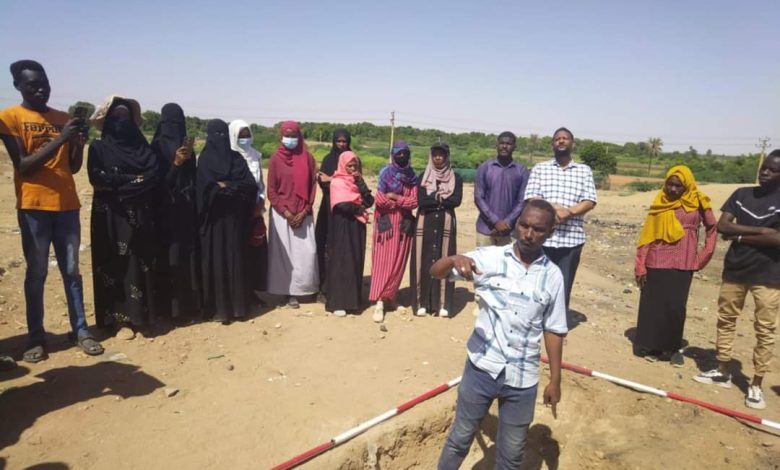Reports
Archaeological Discovery of Shanan Fortress: Early Compensation for Sudan’s Artifact Theft

Sudan Events – Agencies
In a recent archaeological discovery, a Sudanese team announced the uncovering of a historic site at Shanan Fortress, located in northern Sudan. This site joins hundreds of archaeological sites throughout the country. Over the years, numerous artifacts have been stolen, damaged, and sold cheaply both inside and outside of Sudan, making the Shanan Fortress discovery a form of compensation, according to archaeology enthusiasts.
The team comprised professors and students from the Department of Archaeology and Tourism at Shendi University. They focused their efforts on Shanan Fortress, where excavations revealed artifacts depicting a rich and complex lifestyle from thousands of years ago. These discoveries include primitive stone tools, remnants of temples, and burial sites, reflecting the culture and beliefs of ancient regional peoples.
When students and researchers, led by Dr. Othman Suleiman, a professor in Shendi University’s Archaeology and Museums Department, began their excavations, their aim was not merely to find artifacts or educate archaeology students, but to revive the stories of ancient civilizations.
Dr. Suleiman explains: “The stone tools we discovered show signs of frequent use, indicating the skill of their creators and their interaction with nature. These tools may have been used for hunting and gathering food, reflecting a daily life closely tied to natural resources.” Excavations suggest the existence of a stable community that relied on the Nile not only as a life source but also as a religious symbol. Some skeletons were found in various burial positions, suggesting unique funerary rituals that reflect the beliefs dominating life and death at the time.
Monumental Evidence
As researchers delved deeper into the site, they began uncovering traces of the Meroitic civilization, a culture that thrived along the Nile in northern Sudan and held a unique role in cultural and trade exchanges with neighboring civilizations, such as Egyptian and Roman.
Dr. Mahmoud Suleiman, the Director of Archaeological Sites at Meroe under the General Authority for Antiquities and Museums, notes that the remains of massive temples and ornately decorated tombs, with colorful murals found in the Shanan area, bear testament to the grandeur and development of Meroitic civilization. He adds: “These murals are not just decorations but silent documents detailing the beliefs and rituals of the Meroites, and their relations with neighboring cultures through shared symbols.”
Excavations also uncovered intricately designed pottery with geometric patterns, showcasing the era’s craftsmanship and artistic taste. Studies suggest these vessels were used in an advanced agricultural economy, likely for crop storage or religious rituals, underscoring the close link between the economy and religion in that period.
Shanan Fortress, located amid Meroe’s vast plains between the Nile River and fertile valleys, lies approximately 180 kilometers north of Khartoum and about two kilometers from Shendi in the Nile River State. Experts agree that it will serve as a witness to the successive human civilizations in Sudan, whose history spans from the Stone Age to the Kingdom of Kush era. Shanan Fortress encapsulates the grandeur of the civilizations that thrived along the Nile, offering a window into Sudan’s rich history.
Challenges Facing the Discovery
Despite its historical significance, Shanan Fortress faces multiple threats to its preservation. Climate change and population encroachment, which increased after the outbreak of conflict in Sudan and the resulting displacement of thousands, are among the primary challenges.
Dr. Hisham Khidir Karrar, an archaeology researcher, says, “Human challenges complicate efforts to preserve the site, including urban expansion and vandalism.” Although Shanan Fortress has not experienced looting like some other museums and sites affected by the current conflict, a lack of awareness about the importance of preserving this cultural heritage makes human encroachment a real threat.
In this regard, the local community plays a crucial role in protecting Shanan Fortress. Raising awareness among residents can foster a sense of belonging, motivating them to preserve this heritage as part of their identity, according to Karrar. He emphasizes the need to encourage locals to report any acts of vandalism or attempts to smuggle artifacts, noting that “the local community can play a decisive role in protecting and preserving the site for future generations.”
Women’s Role
The household tools and pottery uncovered at the site reflect women’s role in the daily life of these ancient societies. These artifacts may have been used for food preparation or grain storage, highlighting women’s vital role not only as family caretakers but also in religious and social rituals. Through studying these artifacts, we gain insights into how women performed rituals related to life cycles, from religious practices to funerary ceremonies, underscoring their role in passing down values and beliefs across generations.
Religion and Life
Religion held a central place in the lives of ancient inhabitants, evident not only in the grand temples and religious symbols discovered but also through daily rituals. Burial structures at Shanan Fortress indicate detailed funerary customs, where the deceased were prepared for the journey to the afterlife based on beliefs tied to the worship of ancient deities like Apedemak and natural elements such as mountains and the Nile.
Excavations also uncovered evidence of complex burial practices, with different methods depending on social or religious status, as well as religious symbols and tools used in these rituals.



